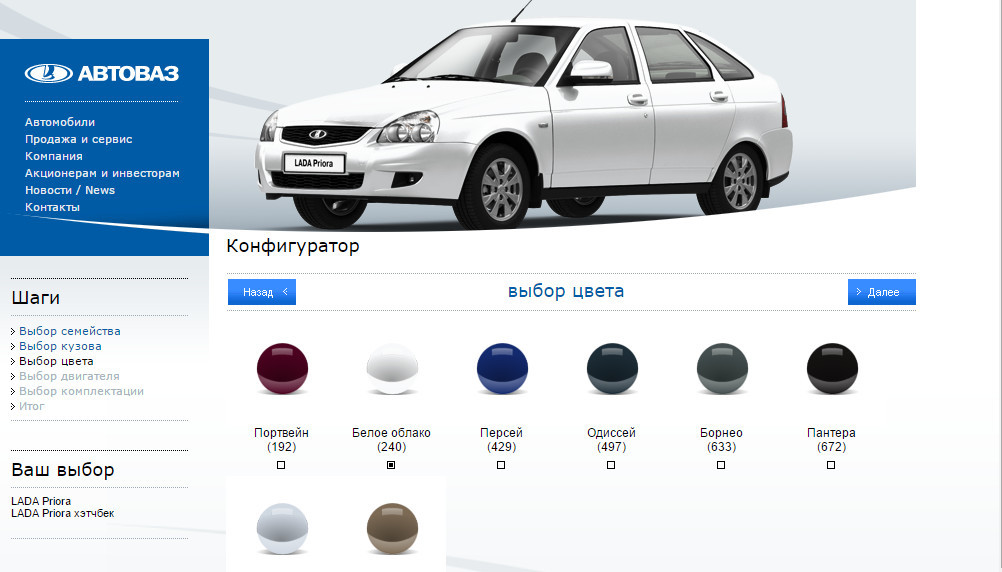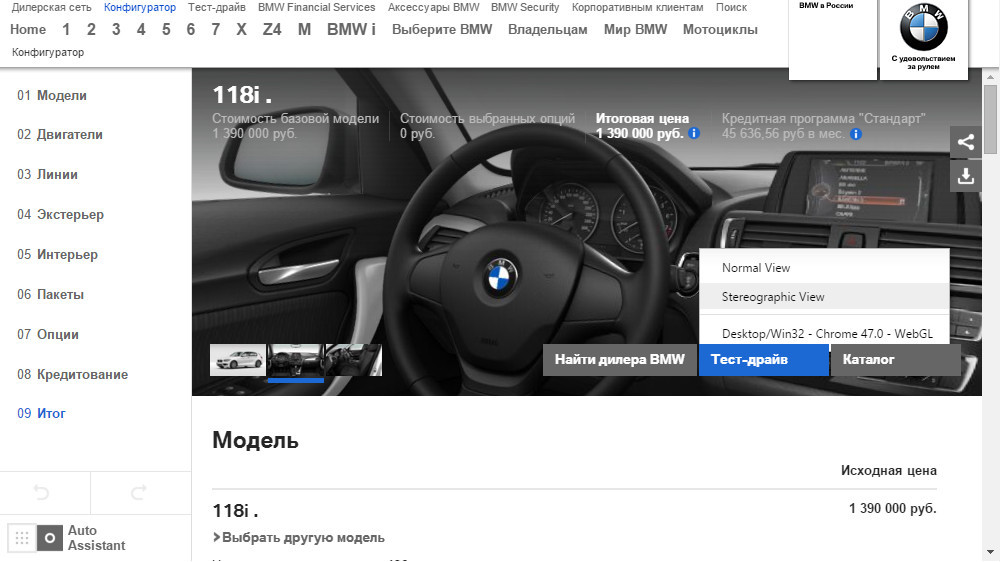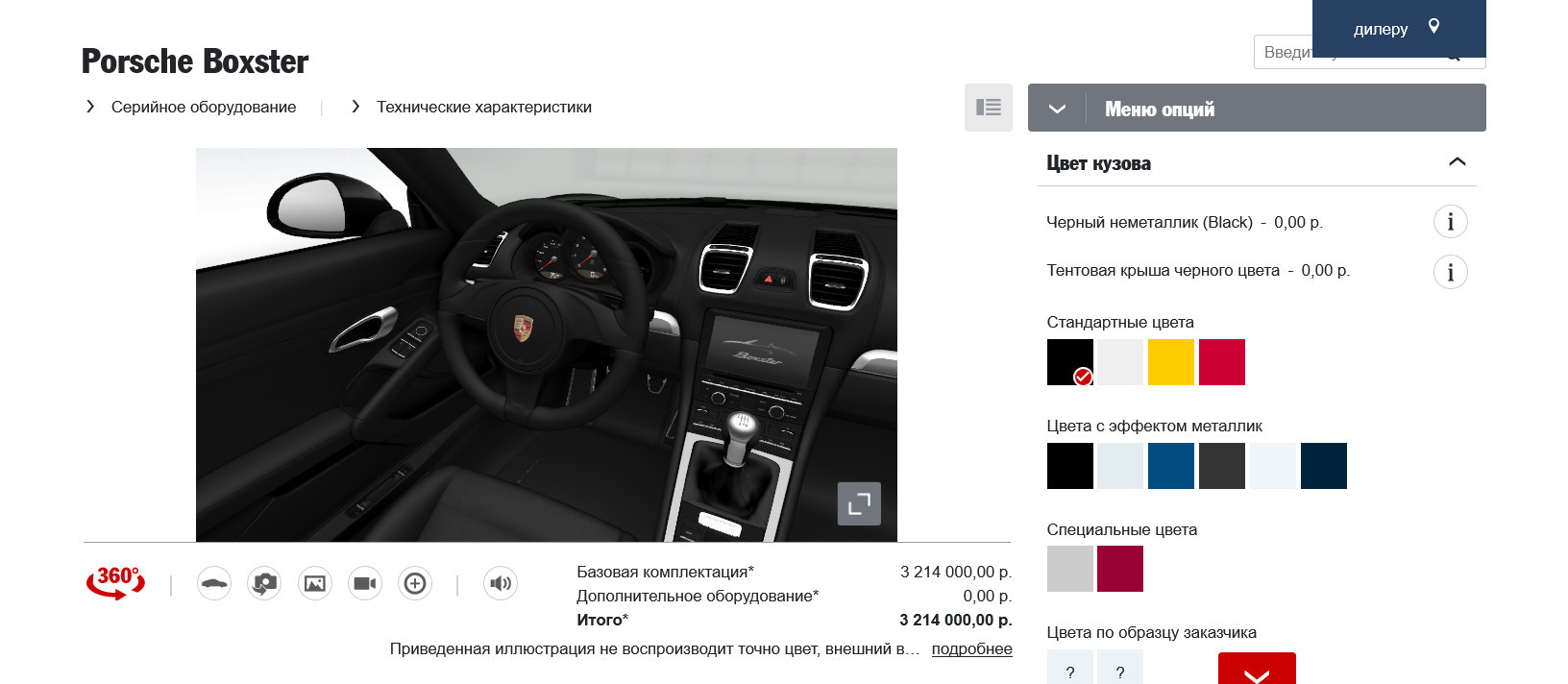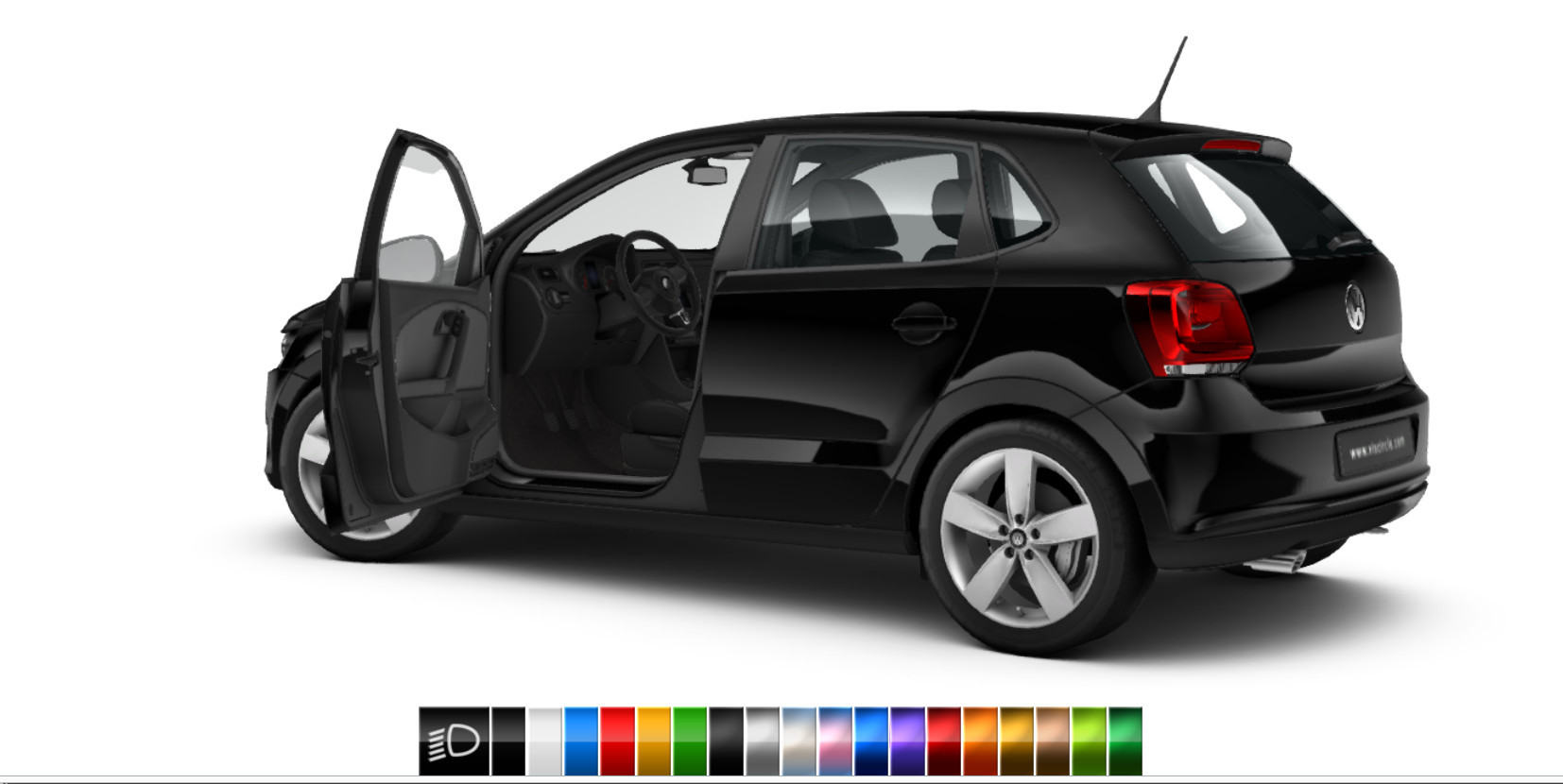Automotive configurators as a mirror of the web technology revolution
In a recent article, I looked at interesting WebGL projects. Among them was the presentation of the car Porsche 911. A beautiful, technically competent application, of course, attracts buyers, but how effective is it?
Car manufacturers are very rational. Traditionally, their official sites serve the main thing - to increase sales. It is not surprising that such automotive resources keep their nose “downwind” and very quickly react to any technological developments in the field of site building. The most sensitive part to this is the so-called configurator. It is present on the websites of all well-known brands and allows you to choose a car to suit your requirements: determine the series, body color, upholstery, engine power, type of wheels, etc. Thus, a potential buyer “sees” what he needs, and also receives information about the final cost of the assembled car and even credit offers. It is clear that the automotive configurator must be fast, convenient, descriptive, as useful and modern as possible. This is a kind of “mirror” of current web technologies.

To be honest, starting this study, I expected to see steep three-dimensional configurators, with the possibility of a comprehensive inspection of the selected machine, which changes its appearance in real time. The present turned out to be much more prosaic ...
')

First of all, I opened the site of Avtovaz. Still, it is interesting what can boast domestic producers. In addition to the painfully familiar lineup, I found the configurator. Qualitatively done, but clearly using simple, familiar web technologies. The information is presented mostly in text form. Yes, when changing the model of a car and choosing a color, the main picture changes. But that's all. It may be worth looking at foreign brands ...

In order not to suffer, I immediately aimed at the prestigious auto industry. Mercedes-benz is the most famous brand. Oh, the Germans, something can surprise! As you can see in the picture configurator of this brand. If you look closely, then in the right corner next to the photo of the car you can see the characteristic 3D symbol. Here it is, I thought, and enthusiastically pulled the proposed lever. Alas, the Germans did not meet my expectations and slipped not real 3D, but something made from pre-rendered screenshots of the machine from different angles. Yes, this configurator looks cooler than Avtovazovsky, but again it uses standard web technologies.
As a result, I went through about a dozen sites of the largest car manufacturers: Cadillac, Volvo, Ford, Mitsubishi, etc. Everywhere the same thing - beautiful and not very, with or without pseudo 3D. Some configurators look very technological, but still this is a simple 2D. No innovations have been found so far.

The mood began to change when I looked at the site of the BMW manufacturer. Its configurator is a familiar mixture of images, information, heaps of eye-pleasing transitions and movements. However, if you collect the car to the end, then you will get a little surprise in the form of a fully three-dimensional visualization. And you can see how the appearance of the car, and its interior. Especially surprised by such a thing as stereo mode. On the screenshot above, there is a context menu where you can select the desired mode. True, I did not understand how to use it, but the first 3D I encountered was already reassuring. As you understand, WebGL is used for its visualization.

Somewhat more interesting is the case with the manufacturers of tuning things for cars. These sites make much more use of modern web technologies. An example is the Alcar configurator . You can choose the model and series of cars, try on any of the disks, twist the car in the window and, of course, order. In principle, clearly, but still there is some feeling of unfinishedness. I could not determine what was used to create the configurator, but obviously not flash. Yes, and 3D looks very strange, maybe again an ingenious mix of code with ordinary rendered pictures.
So why on the websites of car manufacturers, standard technologies are still quoted, because 3D is much more beautiful, more informative than 2D, and therefore more effective in “catching” the client? It seems that developers are afraid to use the most modern features and they have good reason.
To understand why this happens, you need to look into the past. More recently, the leading technology of the web was flash. They did everything on it, from sites to games. And I met some automotive configurators. True, everything was tricky there, and if there was no flash on the user’s computer, a spare standard version was used. Another popular technology was third-party 3D plugins, such as Unity web-player. They were used not only in games, but also in various presentations and designers. Even now you can find resources that require third-party plug-in. I saw the same on the website of one car manufacturer. However, due to some objective reasons, such plugins also went into “fly”.
Now great hopes are placed on WebGL - a technology that replaces outdated plugins. It has its advantages: work on any browsers that support it, regardless of the hardware platform, full 3D. Low-level programming of WebGL is certainly possible, but it has certain difficulties. Therefore, most often use third-party engines. In fact, there are not so many of them, since WebGL is just beginning to conquer the empty space left after the “departure” of the plugins. In addition, there are certain difficulties with the speed of WebGL applications on mobile platforms, and some popular engines are very limited or provide a weak level of quality for mobile systems. Given that the mobile browser segment is a huge part of the global web pie, it is not surprising that big brands are in no hurry to switch to WebGL. There is a feeling of a frozen pause. But if you dig a little on the Internet, you will notice that many studios are already working on WebGL configurators of famous car brands.

First, I came across a working configurator of the Skoda brand. It is quite primitive, with a lot of restrictions. 3D is some kind of jerky, there is no scaling of the model, the showroom is made in the form of slides. Nevertheless, this is a real example of a working machine 3D-configurator. You can choose a model, decide on a color, change some options. The truth gives a little some self-made. The quality of the models is acceptable, the rendering is fast, but some unfinishedness is felt. You can not look at the car from all sides, admire it at night, “feel” the interior. As they say, not very, but it will do. Unfortunately, I was unable to determine the engine on which this visualization was created.

The second I came across was the Porshe configurator (not to be confused with the presentation in another article). Beautifully made, fast and high-quality visualization, an extensive set of options for configuring your car. In comparison with the first considered visualizer Skoda, just heaven and earth. I would say that this is an exemplary application to which you can equal, if not for one “but” - to view it you need a Unity web player. This outdated technology is now not supported in all browsers and is not fully functional for mobile platforms. Obviously, after a while this configurator will disappear from this site. Although beautiful, you will not say anything.

And this Polo is a completely different calico. The configurator is developed by a company from Hannover and will obviously serve as a faithful and true German giant in the automotive industry. This application uses WebGL, so it does not require third-party plug-ins and runs seamlessly on most mobile devices. You can rotate the model in any planes, scale, change the color of the body, turn on the headlights and even open the doors. The Blend4Web engine, on which this presentation is made, produces a high-quality visual image with a very fast render (developers from Russia). According to the information found, the work is still ongoing and the application will soon acquire all the features that a full-fledged configurator will need: you can change disks, interior materials and make a test drive.
So, the world of automotive configurators has stopped at a crossroads. Someone is using already outdated technologies, someone has returned to familiar images and HTML, but work is underway to “assimilate” WebGL and already, probably, soon we will be able to see sites that fully use 3D. After all, three-dimensional graphics offers a three-dimensional, more complete view of things and looks much more presentable.
Car manufacturers are very rational. Traditionally, their official sites serve the main thing - to increase sales. It is not surprising that such automotive resources keep their nose “downwind” and very quickly react to any technological developments in the field of site building. The most sensitive part to this is the so-called configurator. It is present on the websites of all well-known brands and allows you to choose a car to suit your requirements: determine the series, body color, upholstery, engine power, type of wheels, etc. Thus, a potential buyer “sees” what he needs, and also receives information about the final cost of the assembled car and even credit offers. It is clear that the automotive configurator must be fast, convenient, descriptive, as useful and modern as possible. This is a kind of “mirror” of current web technologies.

To be honest, starting this study, I expected to see steep three-dimensional configurators, with the possibility of a comprehensive inspection of the selected machine, which changes its appearance in real time. The present turned out to be much more prosaic ...
')

First of all, I opened the site of Avtovaz. Still, it is interesting what can boast domestic producers. In addition to the painfully familiar lineup, I found the configurator. Qualitatively done, but clearly using simple, familiar web technologies. The information is presented mostly in text form. Yes, when changing the model of a car and choosing a color, the main picture changes. But that's all. It may be worth looking at foreign brands ...

In order not to suffer, I immediately aimed at the prestigious auto industry. Mercedes-benz is the most famous brand. Oh, the Germans, something can surprise! As you can see in the picture configurator of this brand. If you look closely, then in the right corner next to the photo of the car you can see the characteristic 3D symbol. Here it is, I thought, and enthusiastically pulled the proposed lever. Alas, the Germans did not meet my expectations and slipped not real 3D, but something made from pre-rendered screenshots of the machine from different angles. Yes, this configurator looks cooler than Avtovazovsky, but again it uses standard web technologies.
As a result, I went through about a dozen sites of the largest car manufacturers: Cadillac, Volvo, Ford, Mitsubishi, etc. Everywhere the same thing - beautiful and not very, with or without pseudo 3D. Some configurators look very technological, but still this is a simple 2D. No innovations have been found so far.

The mood began to change when I looked at the site of the BMW manufacturer. Its configurator is a familiar mixture of images, information, heaps of eye-pleasing transitions and movements. However, if you collect the car to the end, then you will get a little surprise in the form of a fully three-dimensional visualization. And you can see how the appearance of the car, and its interior. Especially surprised by such a thing as stereo mode. On the screenshot above, there is a context menu where you can select the desired mode. True, I did not understand how to use it, but the first 3D I encountered was already reassuring. As you understand, WebGL is used for its visualization.

Somewhat more interesting is the case with the manufacturers of tuning things for cars. These sites make much more use of modern web technologies. An example is the Alcar configurator . You can choose the model and series of cars, try on any of the disks, twist the car in the window and, of course, order. In principle, clearly, but still there is some feeling of unfinishedness. I could not determine what was used to create the configurator, but obviously not flash. Yes, and 3D looks very strange, maybe again an ingenious mix of code with ordinary rendered pictures.
So why on the websites of car manufacturers, standard technologies are still quoted, because 3D is much more beautiful, more informative than 2D, and therefore more effective in “catching” the client? It seems that developers are afraid to use the most modern features and they have good reason.
To understand why this happens, you need to look into the past. More recently, the leading technology of the web was flash. They did everything on it, from sites to games. And I met some automotive configurators. True, everything was tricky there, and if there was no flash on the user’s computer, a spare standard version was used. Another popular technology was third-party 3D plugins, such as Unity web-player. They were used not only in games, but also in various presentations and designers. Even now you can find resources that require third-party plug-in. I saw the same on the website of one car manufacturer. However, due to some objective reasons, such plugins also went into “fly”.
Now great hopes are placed on WebGL - a technology that replaces outdated plugins. It has its advantages: work on any browsers that support it, regardless of the hardware platform, full 3D. Low-level programming of WebGL is certainly possible, but it has certain difficulties. Therefore, most often use third-party engines. In fact, there are not so many of them, since WebGL is just beginning to conquer the empty space left after the “departure” of the plugins. In addition, there are certain difficulties with the speed of WebGL applications on mobile platforms, and some popular engines are very limited or provide a weak level of quality for mobile systems. Given that the mobile browser segment is a huge part of the global web pie, it is not surprising that big brands are in no hurry to switch to WebGL. There is a feeling of a frozen pause. But if you dig a little on the Internet, you will notice that many studios are already working on WebGL configurators of famous car brands.

First, I came across a working configurator of the Skoda brand. It is quite primitive, with a lot of restrictions. 3D is some kind of jerky, there is no scaling of the model, the showroom is made in the form of slides. Nevertheless, this is a real example of a working machine 3D-configurator. You can choose a model, decide on a color, change some options. The truth gives a little some self-made. The quality of the models is acceptable, the rendering is fast, but some unfinishedness is felt. You can not look at the car from all sides, admire it at night, “feel” the interior. As they say, not very, but it will do. Unfortunately, I was unable to determine the engine on which this visualization was created.

The second I came across was the Porshe configurator (not to be confused with the presentation in another article). Beautifully made, fast and high-quality visualization, an extensive set of options for configuring your car. In comparison with the first considered visualizer Skoda, just heaven and earth. I would say that this is an exemplary application to which you can equal, if not for one “but” - to view it you need a Unity web player. This outdated technology is now not supported in all browsers and is not fully functional for mobile platforms. Obviously, after a while this configurator will disappear from this site. Although beautiful, you will not say anything.

And this Polo is a completely different calico. The configurator is developed by a company from Hannover and will obviously serve as a faithful and true German giant in the automotive industry. This application uses WebGL, so it does not require third-party plug-ins and runs seamlessly on most mobile devices. You can rotate the model in any planes, scale, change the color of the body, turn on the headlights and even open the doors. The Blend4Web engine, on which this presentation is made, produces a high-quality visual image with a very fast render (developers from Russia). According to the information found, the work is still ongoing and the application will soon acquire all the features that a full-fledged configurator will need: you can change disks, interior materials and make a test drive.
So, the world of automotive configurators has stopped at a crossroads. Someone is using already outdated technologies, someone has returned to familiar images and HTML, but work is underway to “assimilate” WebGL and already, probably, soon we will be able to see sites that fully use 3D. After all, three-dimensional graphics offers a three-dimensional, more complete view of things and looks much more presentable.
Source: https://habr.com/ru/post/367333/
All Articles